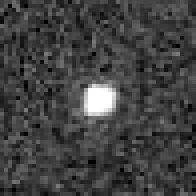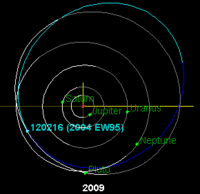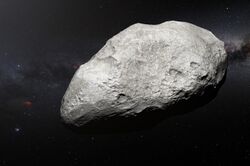Astronomy:(120216) 2004 EW95
 Hubble Space Telescope image of 2004 EW95 taken in 2010 | |
| Discovery[1] | |
|---|---|
| Discovered by | Kitt Peak Obs. |
| Discovery date | 14 March 2004 |
| Designations | |
| (120216) 2004 EW95 | |
| Minor planet category | |
| Orbital characteristics[1] | |
| Epoch 23 March 2018 (JD 2458200.5) | |
| Uncertainty parameter 2 | |
| Observation arc | 4847 days (13.27 yr) |
| |{{{apsis}}}|helion}} | 52.590 astronomical unit|AU (7.8674 Tm) |
| |{{{apsis}}}|helion}} | 26.975 AU (4.0354 Tm) |
| 39.783 AU (5.9515 Tm) | |
| Eccentricity | 0.32193 |
| Orbital period | 250.93 yr (91652 d) |
| Mean anomaly | 359.95° |
| Mean motion | 0° 0m 14.219s / day (n) |
| Inclination | 29.234° |
| Longitude of ascending node | 25.704° |
| 204.67° | |
| Earth MOID | 25.99 AU (3.888 Tm) |
| Jupiter MOID | 21.69 AU (3.245 Tm) |
| Uranus MOID | 9 AU (1.3 Tm)[4] |
| Physical characteristics | |
| Dimensions | 291 km[5] |
| Geometric albedo | 0.04 (dark)[5] |
| Apparent magnitude | ~21.0[6] |
| Absolute magnitude (H) | 6.3[1] |
(120216) 2004 EW95, provisionally known as 2004 EW95, is a resonant trans-Neptunian object in the Kuiper belt located in the outermost regions of the Solar System. It measures approximately 291 kilometers in diameter.[7] It has more carbon than typical of KBOs, and the first to be confirmed as having this composition in this region of space.[8] It is thought to have originated closer to the Sun, perhaps even in the main asteroid belt.[8]
Orbit
Like Pluto, 2004 EW95 is classified as a plutino. It stays in a 2:3 resonance with Neptune.[2][3] For every 2 orbits that a plutino makes, Neptune orbits 3 times.
2004 EW95 is currently 27.0 AU from the Sun,[6] and came to perihelion (q=26.98 AU) in April 2018.[1] This means that this object is currently inside the orbit of the planet Neptune. Like Pluto, this plutino spends part of its orbit closer to the Sun than Neptune is even though their orbits are controlled by Neptune. (Plutinos Huya and (15875) 1996 TP66 are even currently inside the orbit of Neptune.) Simulations by the Deep Ecliptic Survey (DES) show that over the next 10 million years 2004 EW95 can acquire a perihelion distance (qmin) as small as 24.6 AU.[3]
It comes within 9 astronomical unit|AU (1.3 billion km) of Uranus and stays more than 21 AU from Neptune over a 14,000 year period.[4] 2004 EW95 has been observed 158 times with an observation arc of 13 years and has an orbit quality of 2.[1]
Physical characteristics
2004 EW95 has a dark albedo of 0.04, giving it a diameter of about 291 km.[5] Its reflectance spectrum bears striking resemblance to those of some hydrated C-type asteroids, indicating that this object possibly formed in the same environment as the C-type asteroids found today in the outer asteroid belt.[10]
Unlike the majority of small objects in the Kuiper belt observed so far, the visible spectrum of 2004 EW95 has two features, each respectively associated with ferric oxides and phyllosilicates.[10] The presence of a phyllosilicate feature in the spectrum of a minor planet indicates that the rocky component of its composition has been altered by the presence of liquid water at some point since its formation.[11] For this to have occurred on 2004 EW95 in its current orbit and at temperatures of ~35K,[12] significant quantities of thermal energy would have been required. While this energy could have been delivered by a very large chance collision,[13] the strong overall similarity between the modern C-type asteroids in the outer asteroid belt and 2004 EW95 suggests that these objects formed in the same region of the early Sun's protoplanetary disk, much closer to the Sun and at higher temperatures.
The Grand tack hypothesis[14] predicts that the primitive C-type asteroids were dispersed from their formation location by the migrations of Jupiter and Saturn and many were injected into the outer asteroid belt where we find them today. By the same mechanism (and others that result from planetary formation),[15] simulations show that C-types can also be thrown outward to the trans-Neptunian region, where later they may become captured into the mean-motion resonances of Neptune.[14][15]
See also
References
- ↑ 1.0 1.1 1.2 1.3 1.4 1.5 "JPL Small-Body Database Browser: 120216 (2004 EW95)". https://ssd.jpl.nasa.gov/sbdb.cgi?sstr=120216.
- ↑ 2.0 2.1 "MPEC 2009-E53 :Distant Minor Planets (2009 MAR. 30.0 TT)". Minor Planet Center. 2009-03-11. http://www.cfa.harvard.edu/mpec/K09/K09E53.html.
- ↑ 3.0 3.1 3.2 Marc W. Buie. "Orbit Fit and Astrometric record for 120216". SwRI (Space Science Department). http://www.boulder.swri.edu/~buie/kbo/astrom/120216.html.
- ↑ 4.0 4.1 "MPEC 2004-H77 : 2004 EW95". Minor Planet Center. 2004-04-26. http://www.cfa.harvard.edu/mpec/K04/K04H77.html.
- ↑ 5.0 5.1 5.2 Wm. Robert Johnston (22 August 2008). "List of Known Trans-Neptunian Objects". Johnston's Archive. http://www.johnstonsarchive.net/astro/tnoslist.html.
- ↑ 6.0 6.1 "AstDys (120216) 2004EW95 Ephemerides". Department of Mathematics, University of Pisa, Italy. https://newton.spacedys.com/astdys/index.php?pc=1.1.3.0&n=2004EW95.
- ↑ St. Fleur, Nicholas (10 May 2018). "This Asteroid Shouldn't Be Where Astronomers Found It". The New York Times. https://www.nytimes.com/2018/05/10/science/asteroid-kuiper-belt.html.
- ↑ 8.0 8.1 "Exiled asteroid discovered in outer reaches of solar system: ESO telescopes find first confirmed carbon-rich asteroid in Kuiper Belt" (in en). ScienceDaily. https://www.sciencedaily.com/releases/2018/05/180509081954.htm.
- ↑ "Exiled Asteroid Discovered in Outer Reaches of Solar System – ESO telescopes find first confirmed carbon-rich asteroid in Kuiper Belt". https://www.eso.org/public/news/eso1814/.
- ↑ 10.0 10.1 Seccull, Tom; Fraser, Wesley C.; Puzia, Thomas H.; Brown, Michael E.; Schönebeck, Frederik (2018). "2004 EW95: A phyllosilicate bearing carbonaceous asteroid in the Kuiper Belt". The Astrophysical Journal 855 (2): L26. doi:10.3847/2041-8213/aab3dc. Bibcode: 2018ApJ...855L..26S.
- ↑ Fornasier, S.; Lantz, C.; Barucci, M. A.; Lazzarin, M. (2014). "Aqueous alteration on main belt primitive asteroids: Results from visible spectroscopy". Icarus 233: 163–178. doi:10.1016/j.icarus.2014.01.040. Bibcode: 2014Icar..233..163F.
- ↑ Mommert, M.; Harris, A. W.; Kiss, C.; Pál, A.; Santos-Sanz, P.; Stansberry, J.; Delsanti, A.; Vilenius, E. et al. (2012). "TNOs are cool: A survey of the trans-Neptunian region V. Physical characterization of 18 Plutinos using Herschel-PACS observations". Astronomy and Astrophysics 541 (A93): A93. doi:10.1051/0004-6361/201118562. Bibcode: 2012A&A...541A..93M.
- ↑ Rubin, Alan E. (1995). "Petrologic evidence for collisional heating of chondritic asteroids". Icarus 113 (1): 156–167. doi:10.1006/icar.1995.1013. Bibcode: 1995Icar..113..156R.
- ↑ 14.0 14.1 Walsh, Kevin J.; Morbidelli, Alessandro; Raymond, Sean N.; O'Brien, David P.; Mandell, Avi M. (2011). "A low mass for Mars from Jupiter's early gas-driven migration". Nature 475 (206): 206–209. doi:10.1038/nature10201. PMID 21642961. Bibcode: 2011Natur.475..206W.
- ↑ 15.0 15.1 Raymond, Sean N.; Izidoro, Andre (2017). "Origin of water in the inner Solar System: Planetesimals scattered inward during Jupiter and Saturn's rapid gas accretion". Icarus 297: 134–148. doi:10.1016/j.icarus.2017.06.030. Bibcode: 2017Icar..297..134R.
External links
- (120216) 2004 EW95 at the JPL Small-Body Database
- Seccull, Tom; Fraser, Wesley C.; Puzia, Thomas H.; Brown, Michael E.; Schönebeck, Frederik (2018). "2004 EW95: A Phyllosilicate-bearing Carbonaceous Asteroid in the Kuiper Belt". The Astrophysical Journal 855 (2): L26. doi:10.3847/2041-8213/aab3dc. Bibcode: 2018ApJ...855L..26S.
 |



